Abstract
Product disassembly is an effective means of waste recycling and reutilization that has received much attention recently. In terms of disassembly efficiency, the number of disassembly skills possessed by workers plays a crucial role in improving disassembly efficiency. Therefore, in order to effectively and reasonably disassemble discarded products, this paper proposes a partial parallel disassembly line balancing problem (PP-DLBP) that takes into account the number of worker skills. In this paper, the disassembly tasks and the disassembly relationships between components are described using AND–OR graphs. In this paper, a multi-objective optimization model is established aiming to maximize the net profit of disassembly and minimize the number of skills for the workers. Based on the bat algorithm (BA), we propose an improved discrete bat algorithm (IDBA), which involves designing adaptive composite optimization operators to replace the original continuous formula expressions and applying them to solve the PP-DLBP. To demonstrate the advantages of IDBA, we compares it with NSGA-II, NSGA-III, SPEA-II, ESPEA, and MOEA/D. Experimental results show that IDBA outperforms the other five algorithms in real disassembly cases and exhibits high efficiency.
Keywords:
parallel disassembly lines; discrete bat algorithm; multi-objective optimization; disassembly skills MSC:
90-08
1. Introduction
In a typical disassembly line, there are transmission devices and workstations that play a crucial role in the disassembly process. Workers and/or robots perform disassembly tasks at these workstations. The disassembled parts are transferred from one workstation to the next through a transmission belt. The disassembly problem belongs to the manufacturing industry [1]. The disassembly line balancing problem (DLBP) is a field of study that focuses on the assignment of disassembly tasks to workstations, taking into consideration the precedence relationships among tasks. In the context of DLBP research, the design of the disassembly line layout is an important topic of investigation. The most commonly used disassembly line layouts are linear [2], U-shaped [3], two-sided [4], and parallel [5]. In the process of disassembly, multiple lines and work stations need to be balanced at the same time. Compared with other disassembly lines, parallel disassembly lines have obvious advantages. It can realize simultaneous disassembly of different types of products, i.e., the same type of product is assigned to a dedicated disassembly line. Meanwhile, the compact layout of parallel disassembly lines can reduce the movement of workers, greatly improve the work efficiency, and reduce the standby time of workstations.
As for parallel DLBP (PDLBP), Pistolesi et al. [6] construct a multi-objective model that maximizes the degree of parallelism, while minimizing disassembly time and the number of rotated products. The authors propose a tensorial memetic algorithm that is tested on real disassembly instances of a smartphone and washing machine. Liang et al. [7] focus on the reasonable arrangement of disassembling equipment and establish a nonlinear model that minimizes the length of the line and the number of workstations. The authors present an enhanced evolution algorithm that performs better than four heuristic peers.
For economic reasons, complete disassembly of a product may not be necessary [8]. Therefore, disassembly is usually a partial process [9,10]. As for partial DLBP, Jeremy et al. [11] develop a genetic algorithm to obtain near-optimal disassembly sequences and apply it to solve the real disassembly instance of a coffeemaker. Pistolesi et al. [12] construct a multi-objective model that maximizes disassembly profit and minimizes the number of workstations. The authors devise an efficient heuristic algorithm. Following the above researchers, Wang et al. [13] innovatively consider uncertainty and establish a stochastic model. The authors verify the proposed discrete heuristic algorithm by a waste printer.
The skills of workers required by disassembly tasks are an important factor affecting the production efficiency of disassembly lines. However, few researchers consider skilled workers in DLBP. Wang et al. [14] introduce a new DLBP considering workers with different efficiencies and propose a multi-objective discrete heuristic algorithm to obtain high-quality solutions. Yin et al. [15] investigate a partial DLBP, which reasonably considers the skill differences of workers. The authors establish a mixed-integer model to express the problem and present an improved heuristic algorithm to obtain excellent solutions.
PDLBP is NP-hard and researchers have proposed many solutions [16], such as the mixed-integer programming method [17], fuzzy mathematics method [18], and exact algorithm [19]. With the increase in the problem size, the number of feasible solutions increases geometrically. The exact methods [20] are feasible in solving single-objective small-scale instances, but they need a lot of time to solve large-scale instances [21,22]. Therefore, heuristic algorithms are used to solve large-scale PDLBP, including the 2-opt algorithm [23,24], tabu search algorithm [25], simulated annealing algorithm [26], and fuzzy analytic hierarchy process [27,28]. This kind of algorithm has a simple structure and generates feasible solutions according to heuristic rules, but the quality of the solution is difficult to ensure. Due to the relations between sub-targets, it is difficult to establish heuristic rules for multi-objective collaborative optimization.
In recent years, meta-heuristic algorithms [29,30] that imitate the foraging and trapping behavior of natural organisms have been favored by researchers. The bat algorithm was proposed by Yang in 2010 [31], and it belongs to the group of heuristic search algorithms. Its mechanism is to simulate the echolocation principle of bats. Compared with heuristic peers, it is far superior to them in terms of accuracy and effectiveness. Based on these advantages, the bat algorithm is applied to solve the problems of shop scheduling [32], wind power dispatch [33,34], feature selection [35], and image classification [36]. Because of its advantages, the bat optimization algorithm is commonly employed for solving item disassembly and recycling [37]. Therefore, this paper proposes an improved discrete bat algorithm and applies it to solve PP-DLBP. The overview of IDBAis summarized in Table 1. The primary contributions of the paper can be divided into three aspects:

Table 1.
The overviewof the improved discrete bat algorithm.
- A mathematical model of PPDLBP is constructed with the aims to maximize disassembly profit and minimize the number of required worker skills.
- We design two methods for updating individuals: “Priority Preserve Order Crossover” (PPX) operator, which focuses on preserving order, and mutation operator based on precursor task sequences. We propose an IDBA based on the Pareto dominance relationship, selecting the optimal population using the non-dominance principle to guide the algorithm towards the best solution. To maintain global optimization properties, the random flight mode of bats and the flight mode near the optimal solution are mapped to operations with crossover and mutation functions. In this way, IDBA combines the Pareto dominance principle, effectively enhancing the optimization performance of the algorithm.
- The effectiveness of IDBA on PPDLBP is validated in comparison with Nondominated Sorting Genetic Algorithm II (NSGA-II) [38], Nondominated Sorting Genetic Algorithm III (NSGA-III) [39], Strength Pareto Evolutionary Algorithm II (SPEA-II) [40], Electrostatic Potential Energy Evolutionary Algorithm (ESPEA) [41], and Multi-Objective Evolutionary Algorithm based on Decomposition (MOEA/D) [42]. The results indicate that IDBA outperforms five heuristic peers, which proves its high efficiency in solving real disassembly instances.
2. Problem Description
2.1. Problem Statement
The profit of disassembly comes from reusable and high-value parts, which is one of the main objectives of the disassembly enterprise. Therefore, one of the optimization objectives of this paper is to maximize disassembly profit. For multi-product parallel disassembly lines, if similar tasks are assigned to the same workstation and disassembled by skilled workers, the potential of workers will undoubtedly be maximized. Therefore, the other optimization objective of this paper is to minimize the number of required worker skills.
In order to better describe the problem and understand the disassembly sequence of each item, this paper uses AND-OR graphs to represent the relationship between all components or parts and the disassembly task [43]. In the AND-OR graphs, rectangle represents a component. Inside the rectangle, the numbers within angle brackets < > indicate the current component’s number, followed by a series of part numbers that constitute the component. Directed arrows from one component to another signify that the component can be disassembled through a specific task to require the next component. The number of angles formed by two one-way arrows represent the disassembly task. If a rectangle signifies a component that can be disassembled by multiple tasks, only one of the tasks can be selected for disassembly.
Figure 1 shows a ballpoint pen and Figure 2 is its AND-OR graph [44], which has six parts, thirteen disassembly tasks, and fifteen subassemblies. Figure 3 shows a radio and Figure 4 is its AND-OR graph [45], including 10 parts, 30 disassembly tasks, and 29 subassemblies. Figure 5 and Figure 6 show the assignment of tasks and skills on parallel workstations. As can be seen, a parallel disassembly line consists of two disassembly lines (I and II) with one worker at each workstation. Some workers can dismantle tasks on both sides of the line, while others are only responsible for dismantling tasks on one side of the line. In the disassembly sequence, the rectangle represents ballpoint pen (product I) and the circle represents radio (product II). It is worth noting that the disassembly sequence in the figure is decoded by workstation and does not represent the execution time order of the task.

Figure 1.
A ballpoint pen.
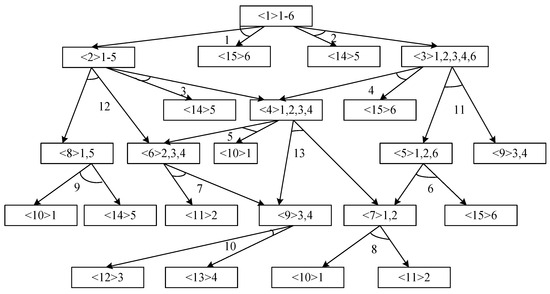
Figure 2.
The AND–OR graph of a ballpoint pen.
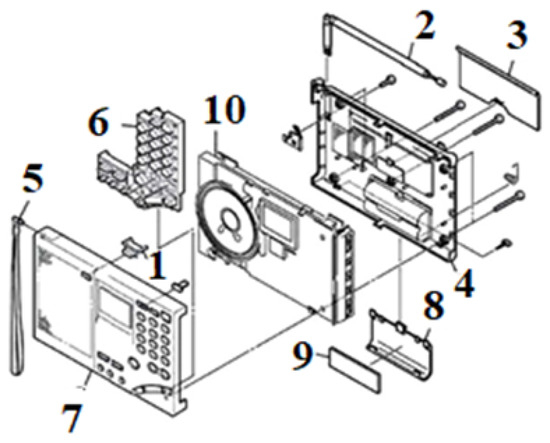
Figure 3.
A radio.
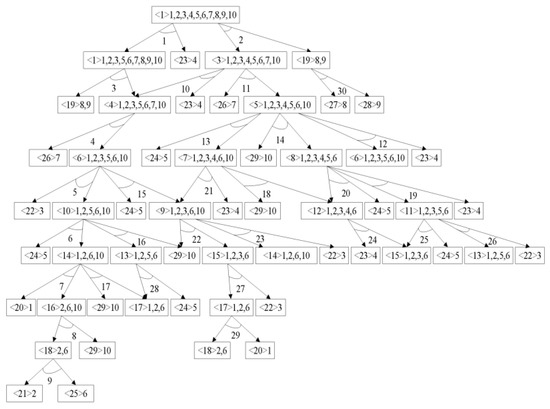
Figure 4.
The AND–OR graph of a radio.
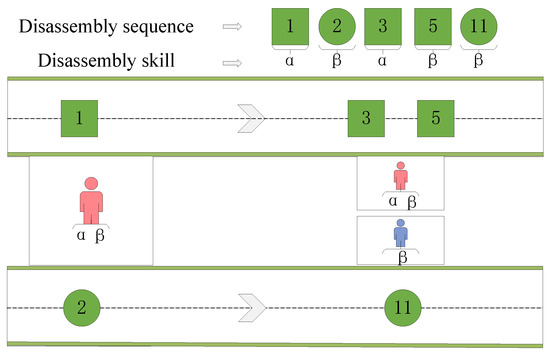
Figure 5.
Task and skill assignment in the first scheme.
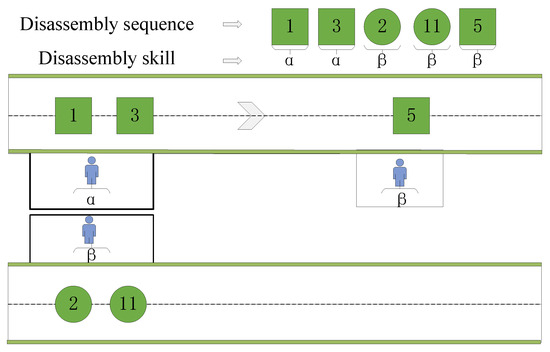
Figure 6.
Task and skill assignment in the second scheme.
As can be seen from Figure 5, disassembly skill is required for disassembly tasks 1 and 3 of the ballpoint pen, and disassembly skill is required for disassembly task 5 of the ballpoint pen and disassembly tasks 2 and 11 of the radio. Moreover, disassembly tasks 1 and 2 are assigned to W1, disassembly tasks 3 and 5 are assigned to W2, and disassembly task 11 is assigned to W3. According to the required skills of each task, the types of workers can be obtained. It is easy to find that the number of workers is three, i.e., two workers with skills and and one worker with skill . Disassembly tasks 1 and 3 both require disassembly skill . If they are assigned to the same workstation, the first assignment scheme will cluster disassembly tasks of the same type, which will undoubtedly help workers to exert their enthusiasm and bring more benefits to the enterprise. As shown in Figure 6, the number of workers is three, but the types of workers are changed. The second assignment scheme requires two workers with skill and one worker with skill .
In these two schemes, the number of workers does not change, but the types of skilled workers do.In the second scheme, the multi-skilled workers are not needed. The calculation method of skill number is described in Figure 7. The task type of each workstation in the first scheme is 2, the required skill is 2, and the total skill number is 4. The task type of each workstation in the second scheme is 1, the required skill is 1, and the total skill number is 2. In the transformation process from Figure 5 to Figure 6, the second scheme has an obvious advantage in improving the efficiency of the enterprise. Furthermore, if the number of skills involved in task execution is increased, the probability of task quality degradation and risk enhancement is significantly reduced. Therefore, this paper studies PPDLBP based on the above-mentioned characteristics.

Figure 7.
Two skill assignment schemes.
2.2. Model Assumptions
To facilitate the mathematical description of the model, we make the following assumptions:
- There are two disassembly lines. The preset cycle time of the two disassembly lines can be different.
- The walking time of workers between the two disassembly lines is ignored.
- The AND-OR graph, precedence relationship matrix, and incidence matrix of each product are known.
- The disassembly time of each task is given.
2.3. Notations
2.4. Mathematical Model
s.t.
The objective Function (1) represents the maximum disassembly profit of the products. Its first term calculates the profit of subassembly s when task i is disassembled at line l of workstation m, and the second term gives the cost of performing task i. The objective Function (2) minimizes the total number of disassembly skills used by workers on the workstation. Constraint (3) states that each task can be assigned to at most one workstation. Constraint (4) limits the cycle time of each workstation. Constraint (5) implies that task i immediately precedes task j. Constraint (6) means that if task j is performed, the execution of the immediately preceding task i of task j must be ensured. Constraint (7) guarantees that the conflict relation of tasks must be satisfied. Constraint (8) indicates that the worker on the workstation needs to use the corresponding disassembly skill to perform the task. Constraint (9) imposes that workstations are enabled in sequence. Constraint (10) refers to the range of decision variables.
3. Improved Discrete Bat Algorithm
The bat algorithm isoriginally designed to solve continuous problems. However, some researchers have discretized the algorithm to solve practical problems. When solving the famous traveling salesman problem, Osaba et al. [46] use Hamming distance to represent the velocity difference between bats, and adopt 2-opt and 3-opt operators in the generation stage of the new solution. As for the shop scheduling problem, Luo et al. [47] design several neighborhood operators to discretize the bat algorithm. To sum up, the bat algorithm for solving continuous optimization problems is no longer suitable for solving discrete problems, so it is necessary to design its continuous optimization operators to solve discrete problems. These designs mainly include designing adaptive combinatorial optimization operators to replace continuous formula expression.
In this paper, we propose IDBA to solve PPDLBP. The improvement strategies mainly include mapping the continuous velocity and displacement formulations into combinatorial optimization operators. Compared with heuristic peers, in addition to the different optimization operator design, the NSGA-II non-dominated sorting method and crowded distance strategy are used in multi-objective optimization. The following subsections introduce the main steps of IDBA.
3.1. Encoding
IDBA uses a vector for encoding. As shown in Figure 8, represents a feasible solution for this disassembly sequence. The green rectangle represents the disassembly task of product I, where the disassembly sequence of tasks is 1, 3, 4, and 6. Similarly, the orange rectangle represents the disassembly task of product II, where the disassembly sequence of tasks is 2, 4, 3, and 5. These tasks of two products are sequentially assigned to corresponding workstations.

Figure 8.
Encoding scheme.
3.2. Generating Feasible Solution
In PPDLBP, we consider two disassembly lines, each of which is assigned a single product type. For this reason, we generate solutions by sequential insertion, which greatly guarantees the randomness and completeness of the disassembly sequence. The steps of generating a feasible solution are outlined in Algorithm 1.
| Algorithm 1: Generating feasible solution |
| Input: Products I and II |
| Output: |
| Begin |
|
| End |
3.3. Decoding
The decoding process involves assigning the disassembly sequence to the corresponding workstations. Figure 9 shows the complete decoding process. The principle of task assignment states that the total time for each workstation cannot exceed its cycle time. After assigning tasks, the objective function in the mathematical model is calculated based on the assignment of each workstation.
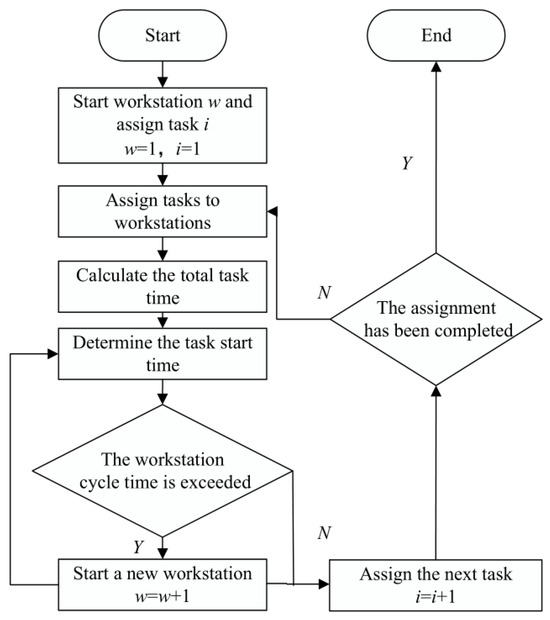
Figure 9.
Decoding process.
3.4. Population Initialization
In this paper, each individual in the population corresponds to a feasible disassembly sequence. A certain number of individuals in the population form the population size. The population initialization process is similar to the encoding process. To ensure the randomness of the population, we adopt a random insertion method. Specifically, nodes from product II are inserted into the disassembly sequence of product I. When generating a feasible disassembly sequence for PPDLBP, it is essential to ensure the disassembly order relationship of each disassembly product on the parallel disassembly line. Taking the parallel disassembly line of two simple product components as an example, the generated disassembly sequence of each product using the random integer method may not necessarily be feasible. Therefore, we need to adjust the generated sequence to make it a feasible disassembly sequence. The process is illustrated in Figure 10.
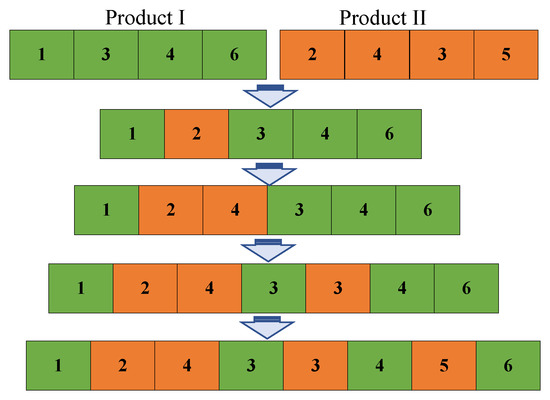
Figure 10.
The process of population initialization.
As shown in Figure 11, the process includes three stages, involving addition, subtraction, and swap operations. In the addition stage, we add tasks to the existing infeasible sequence. Specifically, task 6 should be added before task 1, task 5 before task 2, and task 8 before task 3. The next stage is the subtraction stage, which aims to remove conflicting tasks. Conflicting tasks cannot coexist in the same disassembly sequence. For example, task 4 conflicts with task 7, and thus task 4 is removed. The last stage is the swap operation. After the completion of the first two stages, the feasibility of the disassembly sequence cannot be guaranteed. This is because some original disassembly operations do not meet the precedence relationship, and need to be adjusted. For example, task 3 and task 9 need to be adjusted to meet the precedence relationship.
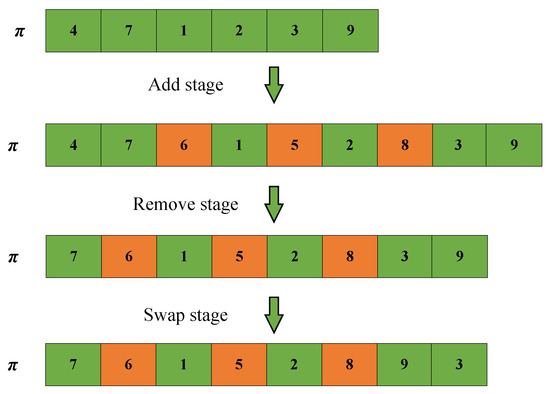
Figure 11.
Checking and adjusting disassembly process.
3.5. Update of Individuals
We design two methods for updating individuals. The first one is the Precedence Persevere Crossover (PPX) operator, which focuses on preserving precedence. The second method is a mutation operator based on the immediate predecessor task sequence. Figure 12 illustrates the process of a bat flying towards the optimal individual. After obtaining successive individuals , a random individual is selected from the current Pareto solution set, and the PPX operator is executed. By observing the mechanism, it can be seen that the operator can effectively inherit the excellent genes of its parent. The update strategy (PPX operator) for individuals is presented in Algorithm 2.
| Algorithm 2: PPX operator |
| Input : , , MASK. |
| Output: . |
| Begin |
|
| End |
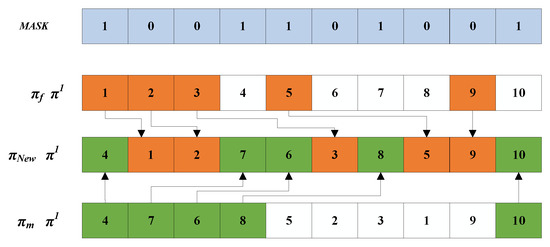
Figure 12.
PPX operator.
As a strategy based on local variation, IDBA can escape from the local optimal solution, thereby improving its performance. The strategy of the mutation operator is also based on the characteristics of neighborhood mutation. As shown in Figure 13, the process of the mutation operator includes randomly selecting a mutation point, then finding its compact pre-task and compact successor task. After that, the position of the mutation point can be dynamically adjusted to generate neighborhood solutions. For example, task 6 is selected as the random mutation point. According to the precedence relation matrix P, it is known that the immediate tasks of task 6 are tasks 7 and 2. Thus, there are two adjustment positions for task 6: one is behind task 8 and the other is behind task 5. Finally, it can be randomly inserted at one of them.
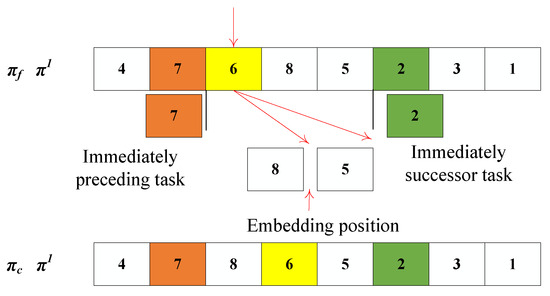
Figure 13.
Mutation operator.
3.6. Population Update Strategy
According to the methods of rank and crowding distance, we choose the first n individuals to combine the current population, and that combination becomes the next population. In the process of multi-objective optimization, individual fitness is determined by multiple objective functions, and individual fitness is determined by the dominance rule. Assume that there are U objectives, and if Equation (11) is satisfied, then solution is dominated by solution . The IDBA framework is shown in Figure 14. The algorithm is terminated when the predefined maximum number of iterations is reached.
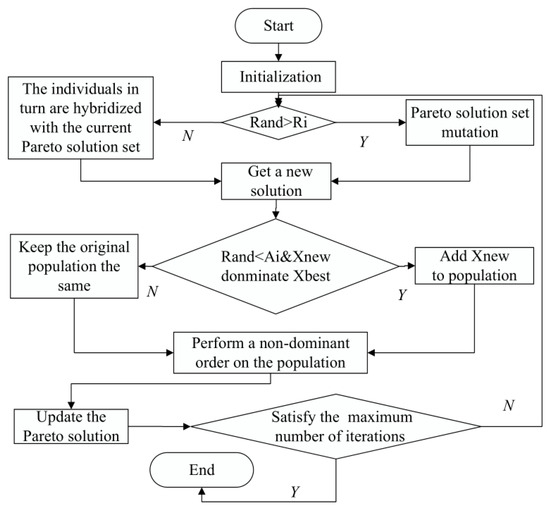
Figure 14.
The flow chart of IDBA.
4. Experiments
4.1. Experimental Design
In this study, we select a hammer drill, a radio, two types of ballpoint pens, and a desk lamp as experiment disassembly products. The AND-OR graphs for the first ballpoint pen and the radio are presented in the second section. The AND-OR graphs for the remaining products are shown in Figure 15, Figure 16 and Figure 17. Additionally, Table 2 lists the number of disassembly tasks and disassembly components for each of these five items. These products were randomly combined into three multi-product instances, as shown in Table 3. We compare IDBA with the five solution strategies, NSGA-II, NSGA-III, SPEA-II, ESPEA, and MOEA/D. NSGA-II, NSGA-III, and SPEA-II, as the most popular multi-objective genetic algorithms, have a clear advantage in terms of searching for optimal solutions. If there is no specific preference, ESPEA can perform well in finding an equidistant approximation of the Pareto frontier. MOEA/D enjoys lower computational complexity and higher problem-solving efficiency. All computational experiments are being performed on a laptop with a 2.0 GHz AMD Ryzen 74700U CPU and 16 GB of memory, using IntelliJ IDEA 2020.1. Each algorithm is run 20 times on the Jmetal framework. For all algorithms, the population size is set to 100, the number of iterations is 100, the crossover probability is 0.7, the mutation probability is 0.5 times the inverse of the task sequence length, and the workstation cycle time is 50.
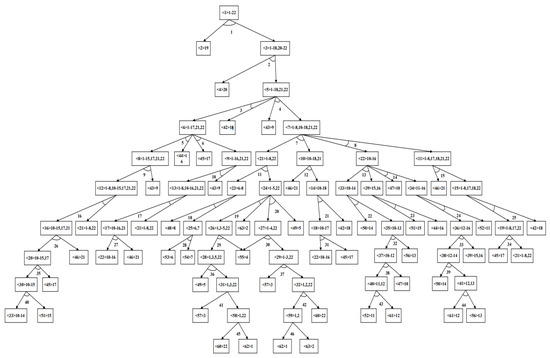
Figure 15.
The AND–OR graph of hammer drill.
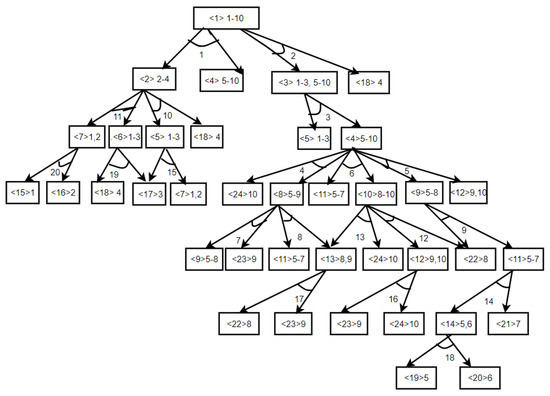
Figure 16.
The AND–OR graph of another ballpoint.
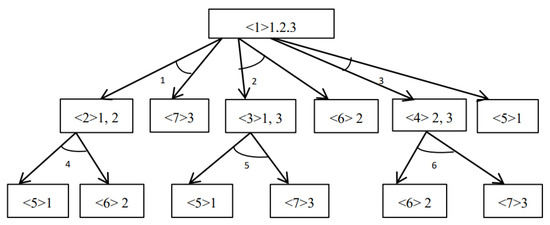
Figure 17.
The AND–OR graph of desk lamp.

Table 2.
Information of products.

Table 3.
Information of disassembly instances.
Table 4 shows the performance comparison of IDBA with the five heuristic peers. The evaluation indicators used are inverted generational distance metric (IGD-metric), hypervolume-metric (HV-metric), and Epsilon-metric. It is clear from this table that IDBA outperforms the five heuristic peers in all indicators. In the following, we use the results of Case 1 to further illustrate the superiority of IDBA. Figure 18 shows the changing trend of the IGD-metric of IDBA and the comparison algorithms with the number of iterations. It can be seen that in the beginning, the IGD-metric of each algorithm is roughly the same, which ensures that the starting conditions of the algorithms are the same, and the initial population difference of each algorithm is not obvious. In the first 10 iterations, all algorithms show a significant downward trend, while the metric of IDBA goes deeper than others. From the 10th iteration to the 20th iteration, each algorithm still has an obvious downward trend. After the 20th generation, the variation trend of each algorithm becomes gentle and the algorithm converges gradually. IDBA has the smallest IGD-metric, meaning it performs better than other algorithms.

Table 4.
Information of disassembly instances.
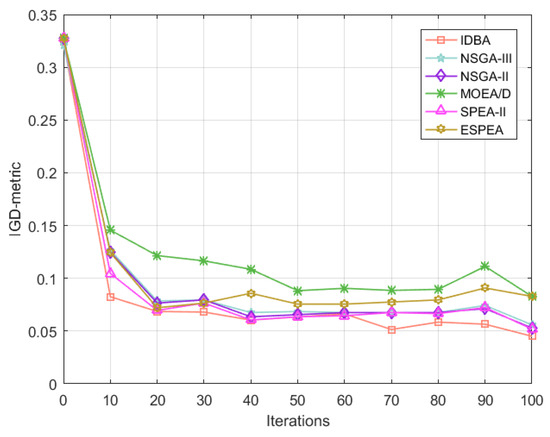
Figure 18.
IGD-metric of each algorithm vs. the number of iterations.
Figure 19 shows the changing trend of the HV-metric of IDBA and the comparison algorithms with the number of iterations. For the first 10 iterations, all algorithms show an obvious upward trend, among which IDBA has the fastest upward rate and the largest HV-metric. From the second 10 iterations, each algorithm still has an obvious upward trend, with a larger HV-metric than before. Due to the limitation of the number of iterations, the HV-metric becomes smaller after 30 iterations with no convergence trend, which reflects that each iteration of the algorithm will affect its performance. In terms of data, IDBA has the best HV-metric and the best fluctuation and convergence. Figure 20 shows the changing trend of Epsilon-metric of IDBA and the comparison algorithms with the number of iterations. It can be clearly seen that Epsilon-metric and IGD-metric have very similar trends.
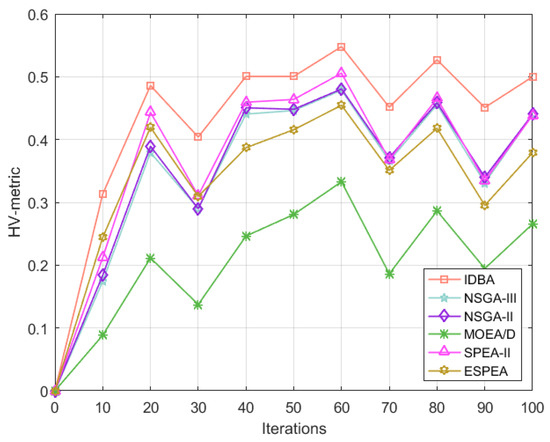
Figure 19.
HV-metric of each algorithm vs. the number of iterations.
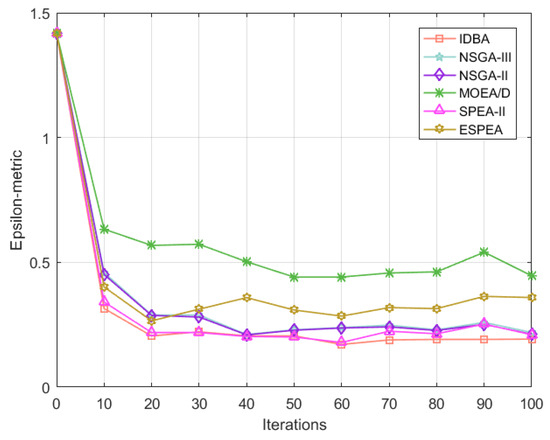
Figure 20.
Epsilon-metric of each algorithm vs. the number of iterations.
4.2. Experimental Results and Analysis
Figure 21 shows the changing trend of IGD-metric under different population sizes. It reveals that the population size has little effect on the algorithm, as well as the fluctuation degree of the algorithm. Notice that the curve of IDBA is always at the bottom of the figure, meaning its IGD metric is the lowest among the six algorithms, so the Pareto solution obtained by IDBA is closest to the real Pareto frontier. From this, we can draw a conclusion, i.e., under the premise that the population meets the maximum Pareto number, as long as the number of iterations of IDBA is sufficient, the algorithm can achieve good convergence in general. Similarly, the test method of IGD-metric is still valid for HV-metric and Epsilon-metric. Figure 22 and Figure 23 illustrate the changing trend of HV-metric and Epsilon-metric under different population sizes, respectively. It is easy to find that HV-metric and Epsilon-metric are consistent with IGD-metric.
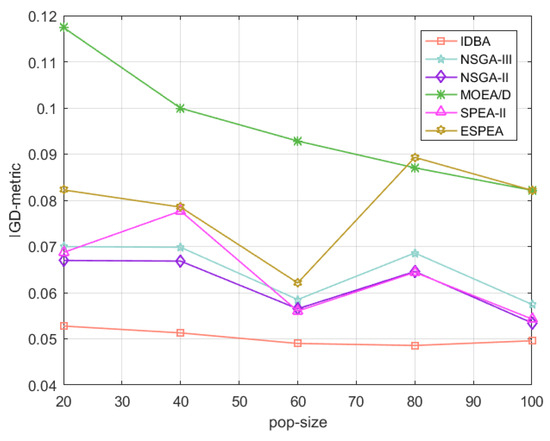
Figure 21.
IGD-metric of each algorithm vs. population size.
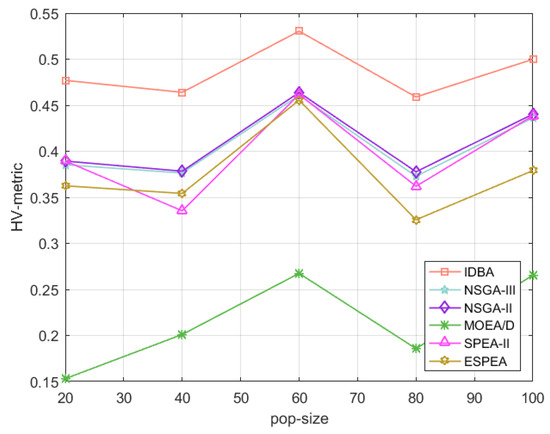
Figure 22.
HV-metric of each algorithm vs. population size.

Figure 23.
Epsilon-metric of each algorithm vs. population size.
To evaluate IDBA, we use three box plots to record the values of IGD-metric, HV-metric, and Epsilon-metric. From a dataset neutrality perspective, the IDBA algorithm is weaker compared to the NSGA-II and SPEA-II algorithms. However, from Figure 24, we can observe that the IGD-metric value for IDBA is lower than the other algorithms, indicating that the algorithm’s solutions are closer to the true Pareto front and the distribution of solutions along the front is more uniform. As shown in Figure 25 and Figure 26, they represent the performance of IDBA and five other algorithms on the HV-metric and Epsilon-metric, respectively. From Figure 25, we can see that the value obtained by IDBA is relatively higher compared to other algorithms, indicating that IDBA performs better according to the HV-metric indicator. Similarly, from Figure 26, we can observe that IDBA’s value is lower than the other algorithms, suggesting that the algorithm’s solutions are closer to the true Pareto front. Therefore, based on the above analysis, IDBA demonstrates high efficiency in solving problems.
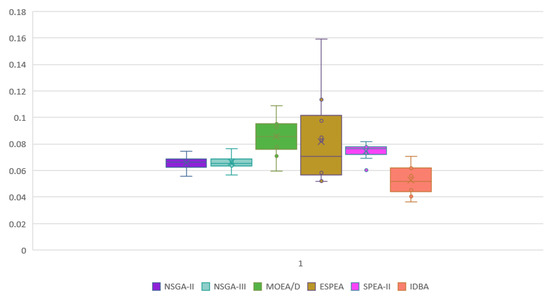
Figure 24.
Box plot of IGD-metric for each algorithm.
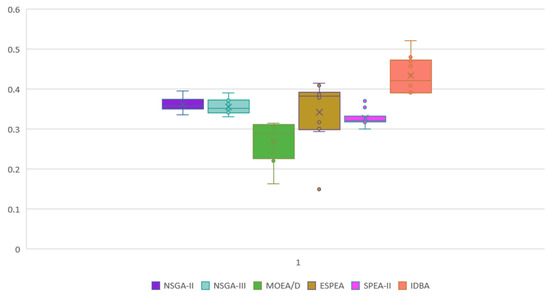
Figure 25.
Box plot of HV-metric for each algorithm.
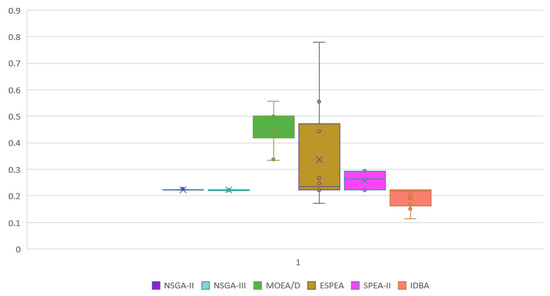
Figure 26.
Box plot of Epsilon-metric for each algorithm.
In multi-objective optimization problems, Pareto frontier can display the distribution of the target value obtained by the algorithm intuitively. It is easy to conclude that the Pareto solution set for the two objects is a curve, which can be represented by a two-dimensional axis . Figure 27 shows the Pareto frontier data graph obtained by each algorithm in Instance 1. The X-axis represents disassembly profit and the Y-axis represents the number of skills . It can be seen that the objective of IDBA is 1630 and the objective of IDBA is 6, whereas the objective of SPEA-II is 1478 and the objective of SPEA-II is 6. Substituting these two sets of points into Equation 11, we obtain , . Therefore, we conclude that high-quality solution sets should be distributed in the lower right part of the figure, and the convergence degree and uniformity of the Pareto solution sets obtained by IDBA are better.
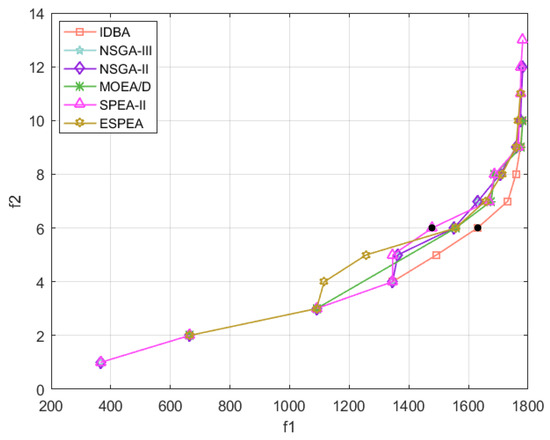
Figure 27.
The Pareto frontier comparison of algorithms.
Figure 28 shows the skill assignment scheme in Case 1. Different product tasks on the disassembly line are represented by circles and rectangles. The types of tasks and workers are distinguished by different colors. It can be clearly seen that the total skill number is 3. Multi-skilled workers are assigned to W1-W3, and the skill number of each workstation is 2. A single-skilled worker is assigned to W4. Obviously, it makes sense to consider skill assignment to save on the use of multi-skilled workers.

Figure 28.
A decoding scheme that considers skill assignment.
5. Conclusions
Compared with traditional linear disassembly lines, parallel disassembly lines have a more compact layout, higher flexibility of workers, and better utilization of workstations. In this paper, an IDBA is designed to address the DLBP. Firstly, we introduce a AND-OR graph of a pen and a radio and describe the basic requirements for worker skills in this paper. Subsequently, we establish a multi-objective model aimed at maximizing disassembly profit and minimizing the required number of worker skills. The model commands that disassembly tasks requiring similar operational skills be placed on the same workstation whenever possible. Finally, we provide a description of the improved discrete bat algorithm, which incorporates position-based PPX operators and mutation operators to improve algorithm performance. Additionally, we are conducting experiments comparing the IDBA algorithm with five other algorithms including NSGA-II, NSGA-III, SPEA-II, ESPEA, and MOEA/D. Evaluation metrics such as IGD-metric, HV-metric, and Epsilon-metric are used in the experiments to demonstrate the outstanding performance of IDBA in solving the multi-objective PPDLBP problem. A detailed validation is conducted with a specific case, showing that IDBA is more suitable for practical disassembly instances. Future research will continue to explore other optimization algorithms or machine learning algorithms to address the DLBP and investigate more efficient and valuable disassembly layouts.
Author Contributions
Writing—original draft preparation, Q.Z. and Y.X.; writing—review and editing, Q.Z., J.W. and L.Q.; supervision, X.G. and S.Q.; data curation, F.H.; visualization, M.Y. All authors have read and agreed to the published version of the manuscript.
Funding
This work is supported in part by NSFC under Grant Nos. 61573089 and 51405075; Liaoning Province Education Department Scientific Research Foundation of China under Grant No. JYTQN2023366; LiaoNing Revitalization Talents Program under Grant No. XLYC1907166; The Natural Science Foundation of Shandong Province under Grant ZR2019BF004.
Data Availability Statement
According to MDPI’s research data policy, we hereby declare that the data applied and generated during the research process are fully reflected in the paper, and the data presented in the paper have been adequately provided and appropriately cited.
Conflicts of Interest
The authors declare no conflicts of interest.
References
- Qi, L.; Su, Y.; Zhou, M.; Abusorrah, A. A State-Equation-Based Backward Approach to a Legal Firing Sequence Existence Problem in Petri Nets. IEEE Trans. Syst. Man Cybern. Syst. 2023, 53, 4968–4979. [Google Scholar] [CrossRef]
- Cui, X.; Guo, X.; Zhou, M.; Wang, J.; Qin, S.; Qi, L. discrete whale optimization algorithm for disassembly line balancing with carbon emission constraint. IEEE Robot. Autom. Lett. 2023, 8, 3055–3061. [Google Scholar] [CrossRef]
- Qin, S.; Zhang, S.; Wang, J.; Liu, S.; Guo, X.; Qi, L. Multi-objective Multi-verse Optimizer for Multi-robotic U-shaped Disassembly Line Balancing Problems. IEEE Trans. Artif. Intell. 2023, 5, 882–894. [Google Scholar] [CrossRef]
- Liang, J.; Guo, S.; Du, B.; Li, Y.; Guo, J.; Yang, Z.; Pang, S. Minimizing energy consumption in multi-objective two-sided disassembly line balancing problem with complex execution constraints using dual-individual simulated annealing algorithm. J. Clean. Prod. 2021, 284, 125418. [Google Scholar] [CrossRef]
- Qin, S.; Li, J.; Wang, J.; Guo, X.; Liu, S.; Qi, L. A Salp Swarm Algorithm for Parallel Disassembly Line Balancing Considering Workers With Government Benefits. IEEE Trans. Comput. Soc. Syst. 2023, 11, 282–291. [Google Scholar] [CrossRef]
- Pistolesi, F.; Lazzerini, B. TeMA: A Tensorial Memetic Algorithm for Many-Objective Parallel Disassembly Sequence Planning in Product Refurbishment. IEEE Trans. Ind. Inform. 2019, 15, 3743–3753. [Google Scholar] [CrossRef]
- Liang, W.; Zhang, Z.; Zeng, Y.; Yin, T.; Wu, T. Modeling and optimization of parallel disassembly line balancing problem with parallel workstations. IEEE Trans. Ind. Inform. 2023, 19, 10684–10692. [Google Scholar] [CrossRef]
- Guo, X.; Zhou, M.; Liu, S.; Qi, L. Multiresource-constrained selective disassembly with maximal profit and minimal energy consumption. IEEE Trans. Autom. Sci. Eng. 2020, 18, 804–816. [Google Scholar] [CrossRef]
- Bentaha, M.; Dolgui, A.; Battaïa, O.; Riggs, R.J.; Hu, J. Profit-oriented partial disassembly line design: Dealing with hazardous parts and task processing times uncertainty. Int. J. Prod. Res. 2018, 56, 7220–7242. [Google Scholar] [CrossRef]
- Çil, Z.; Mete, S.; Serin, F. Robotic disassembly line balancing problem: A mathematical model and ant colony optimization approach. Appl. Math. Model 2020, 86, 335–348. [Google Scholar] [CrossRef]
- Rickli, J.; Camelio, J. Multi-objective partial disassembly optimization based on sequence feasibility. J. Manuf. Syst. 2013, 32, 281–293. [Google Scholar] [CrossRef]
- Pistolesi, F.; Lazzerini, B.; Mura, M.; Dini, G. EMOGA: A Hybrid Genetic Algorithm With Extremal Optimization Core for Multiobjective Disassembly Line Balancing. IEEE Trans. Ind. Inform. 2018, 14, 1089–1098. [Google Scholar] [CrossRef]
- Wang, K.; Li, X.; Gao, L.; Garg, A. Partial disassembly line balancing for energy consumption and profit under uncertainty. Robot.-Comput.-Integr. Manuf. 2019, 59, 235–251. [Google Scholar] [CrossRef]
- Wang, K.; Li, X.; Gao, L.; Li, P. Modeling and Balancing for Disassembly Lines Considering Workers With Different Efficiencies. IEEE Trans. Cybern. 2022, 52, 758–771. [Google Scholar] [CrossRef] [PubMed]
- Yin, T.; Zhang, Z.; Wu, T.; Zeng, Y.; Zhang, Y.; Liu, J. Multimanned partial disassembly line balancing optimization considering end-of-life states of products and skill differences of workers. J. Manuf. Syst. 2023, 66, 107–126. [Google Scholar] [CrossRef]
- Xiang, D.; Lin, S.; Wang, X.; Liu, G. Checking missing-data errors in cyber-physical systems based on the merged process of Petri nets. IEEE Trans. Ind. Inform. 2023, 19, 3047–3056. [Google Scholar] [CrossRef]
- Edis, E.; Edis, R.; Ilgin, M. Mixed integer programming approaches to partial disassembly line balancing and sequencing problem. Comput. Oper. Res. 2022, 138, 105559. [Google Scholar] [CrossRef]
- Özceylan, E.; Paksoy, T. Fuzzy mathematical programming approaches for reverse supply chain optimization with disassembly line balancing problem. J. Intell. Fuzzy Syst. 2014, 26, 1969–1985. [Google Scholar] [CrossRef]
- Koc, A.; Sabuncuoglu, I.; Erel, E. Two exact formulations for disassembly line balancing problems with task precedence diagram construction using an AND-OR graph. IIE Trans. 2009, 41, 866–881. [Google Scholar] [CrossRef]
- Budak, A. Sustainable reverse logistics optimization with triple bottom line approach: An integration of disassembly line balancing. J. Clean. Prod. 2020, 270, 122475. [Google Scholar] [CrossRef]
- Xiang, D.; Liu, G.; Yan, C.; Jiang, C. A guard-driven analysis approach of workflow net with data. IEEE Trans. Serv. Comput. 2021, 14, 1650–1661. [Google Scholar] [CrossRef]
- Xiang, D.; Zhao, F.; Liu, Y. DICER 2.0: A New Model Checker for Data-Flow Errors of Concurrent Software Systems. Mathematics 2021, 9, 966. [Google Scholar] [CrossRef]
- Ren, Y.; Zhang, C.; Zhao, F.; Tian, G.; Lin, W.; Meng, L.; Li, H. Disassembly line balancing problem using interdependent weights-based multi-criteria decision making and 2-Optimal algorithm. J. Clean. Prod. 2018, 174, 1475–1486. [Google Scholar] [CrossRef]
- Zhu, L.; Zhang, Z.; Wang, Y. A Pareto firefly algorithm for multi-objective disassembly line balancing problems with hazard evaluation. Int. J. Prod. Res. 2018, 56, 7354–7374. [Google Scholar] [CrossRef]
- Baygan, M.; Baygan, M. A new method for solving the open shop scheduling using imperialist competitive algorithm and tabu search with regard to maintenance of machine. In Proceedings of the 2015 2nd International Conference on Knowledge-Based Engineering and Innovation (KBEI), Tehran, Iran, 5–6 November 2015; pp. 972–977. [Google Scholar] [CrossRef]
- Roshani, A.; Roshani, A.; Roshani, A.; Salehi, M.; Esfandyari, A. A simulated annealing algorithm for multi-manned assembly line balancing problem. J. Manuf. Syst. 2013, 32, 238–247. [Google Scholar] [CrossRef]
- Elmahmoudi, F.; Abra, O.E.k.; Raihani, A.; Serrar, O.; Bahatti, L. GIS based Fuzzy Analytic Hierarchy Process for Wind Energy Sites Selection in Tarfaya Morocco. In Proceedings of the 2020 IEEE International Conference of Moroccan Geomatics (Morgeo), Casablanca, Morocco, 11–13 May 2020; pp. 1–5. [Google Scholar] [CrossRef]
- Avikal, S.; Mishra, P.; Jain, R. A Fuzzy AHP and PROMETHEE method-based heuristic for disassembly line balancing problems. Int. J. Prod. Res. 2014, 52, 1306–1317. [Google Scholar] [CrossRef]
- Fu, Y.; Ma, X.; Gao, K.; Li, Z.; Dong, H. Multi-objective home health care routing and scheduling with sharing service via a problem-specific knowledge based artificial bee colony algorithm. IEEE Trans. Intell. Transp. Syst. 2023, 25, 1706–1719. [Google Scholar] [CrossRef]
- Li, H.; Gao, K.; Duan, P.; Li, J.; Zhang, L. An Improved Artificial Bee Colony Algorithm With Q-Learning for Solving Permutation Flow-Shop Scheduling Problems. IEEE Trans. Syst. Man, Cybern. Syst. 2023, 53, 2684–2693. [Google Scholar] [CrossRef]
- Yang, X. A new metaheuristic bat-inspired algorithm. In Nature Inspired Cooperative Strategies for Optimization (NICSO 2010); Springer: Berlin/Heidelberg, Germany, 2010; pp. 65–74. [Google Scholar]
- Lu, Y.; Jiang, T. Bi-population based discrete bat algorithm for the low-carbon job shop scheduling problem. IEEE Access 2019, 7, 14513–14522. [Google Scholar] [CrossRef]
- Liang, H.; Liu, Y.; Shen, Y.; Li, F.; Man, Y. A hybrid bat algorithm for economic dispatch with random wind power. IEEE Trans. Power Syst. 2018, 33, 5052–5061. [Google Scholar] [CrossRef]
- Priyanto, Y.T.K.; Maulana, M.F.; Giyantara, A. Dynamic economic dispatch using chaotic bat algorithm on 150kV Mahakam power system. In Proceedings of the 2017 International Seminar on Intelligent Technology and Its Applications (ISITIA), Surabaya, Indonesia, 28–29 August 2017; IEEE: Piscataway, NJ, USA, 2017; pp. 116–121. [Google Scholar]
- Rani, A.S.S.; Rajalaxmi, R. Unsupervised feature selection using binary bat algorithm. In Proceedings of the 2015 2nd International Conference on Electronics and Communication Systems (ICECS), Coimbatore, India, 26–27 February 2015; IEEE: Piscataway, NJ, USA, 2015; pp. 451–456. [Google Scholar]
- Senthilnath, J.; Kulkarni, S.; Benediktsson, J.A.; Yang, X. A Novel Approach for Multispectral Satellite Image Classification Based on the Bat Algorithm. IEEE Geosci. Remote Sens. Lett. 2016, 13, 559–603. [Google Scholar] [CrossRef]
- Zhu, Z.; Xu, Z.; Shen, W.; Yang, D. Selective Disassembly Sequence Planning Based on Genetic Bat Algorithm. J. Zhejiang Univ. Eng. Sci. 2018, 52, 2120–2127, 2135. [Google Scholar]
- Deb, K.; Pratap, A.; Agarwal, S.; Meyarivan, T. A fast and elitist multiobjective genetic algorithm: NSGA-II. IEEE Trans. Evolut. Comput. 2002, 6, 182–197. [Google Scholar] [CrossRef]
- Deb, K.; Jain, H. An Evolutionary Many-Objective Optimization Algorithm Using Reference-Point-Based Nondominated Sorting Approach, Part I: Solving Problems With Box Constraints. IEEE Trans. Evol. Comput. 2014, 18, 577–601. [Google Scholar] [CrossRef]
- Zitzler, E.; Laumanns, M.; Thiele, L. SPEA2: Improving the strength Pareto evolutionary algorithm. TIK-Rep. 2001, 103. [Google Scholar]
- Braun, M.A.; Shukla, P.K.; Schmeck, H. Obtaining Optimal Pareto Front Approximations Using Scalarized Preference Information. In Proceedings of the 2015 Annual Conference on Genetic and Evolutionary Computation, Madrid, Spain, 11–15 July 2015; pp. 631–638. [Google Scholar]
- Zhang, Q.; Li, H. MOEA/D: A Multiobjective Evolutionary Algorithm Based on Decomposition. IEEE Trans. Evol. Comput. 2007, 11, 712–731. [Google Scholar] [CrossRef]
- Guo, X.; Zhang, Z.; Qi, L.; Liu, S.; Tang, Y.; Zhao, Z. Stochastic Hybrid Discrete Grey Wolf Optimizer for Multi-Objective Disassembly Sequencing and Line Balancing Planning in Disassembling Multiple Products. IEEE Trans. Autom. Sci. Eng. 2021, 19, 1744–1756. [Google Scholar] [CrossRef]
- Lu, Q.; Ren, Y.; Jin, H.; Meng, L.; Li, L.; Zhang, C.; Sutherland, J.W. A hybrid metaheuristic algorithm for a profit-oriented and energy-efficient disassembly sequencing problem. Robot. Comput. Integr. Manuf. 2020, 61, 101828. [Google Scholar] [CrossRef]
- Nowakowski, P. A novel, cost efficient identification method for disassembly planning of waste electrical and electronic equipment. J. Clean. Prod. 2018, 172, 2695–2707. [Google Scholar] [CrossRef]
- Osaba, E.; Yang, X.; Diaz, F.; Lopez-Garcia, P.; Carballedo, R. An improved discrete bat algorithm for symmetric and asymmetric Traveling Salesman Problems. Eng. Appl. Artif. Intell. 2016, 48, 59–71. [Google Scholar] [CrossRef]
- Luo, Q.; zhou, Y.; Xie, J.; Ma, M.; Li, L. Discrete Bat Algorithm for Optimal Problem of Permutation Flow Shop Scheduling. Sci. World J. 2014, 2014, 630280. [Google Scholar] [CrossRef] [PubMed]
Disclaimer/Publisher’s Note: The statements, opinions and data contained in all publications are solely those of the individual author(s) and contributor(s) and not of MDPI and/or the editor(s). MDPI and/or the editor(s) disclaim responsibility for any injury to people or property resulting from any ideas, methods, instructions or products referred to in the content. |
© 2024 by the authors. Licensee MDPI, Basel, Switzerland. This article is an open access article distributed under the terms and conditions of the Creative Commons Attribution (CC BY) license (https://creativecommons.org/licenses/by/4.0/).